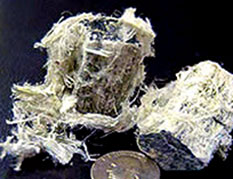What Is Asbestos
During much of the past century, asbestos was widely used for industrial and construction applications. In the 1970s, following enactment of various laws that established Federal agencies such as the Environmental Protection Agency (EPA) and Occupational Safety and Health Administration (OSHA) with missions to protect the environment, the general public, workers, and consumers, some uses of asbestos began to be banned or otherwise regulated. This was due to growing scientific evidence concerning the association of asbestos with serious health effects. For example, in 1973 the EPA banned the use of spray-on building insulation and fireproofing containing more than 1 percent asbestos under authority of the Clean Air Act [EPA 2013] https://www.epa.gov/asbestos/asbestos-laws-and-regulations#phaseout.
Research showing a clear link between asbestos exposure and various serious diseases has resulted in increased regulation of asbestos and high burdens of corporate liability due to cessation of asbestos mining in the United States in 2002 and the dramatic decline in commercial use of imported asbestos in the United States since the late 1970s. However, asbestos is still in use in some products today and asbestos remains in many older buildings [NIOSH 2011a].
Asbestos is the generic name given to a commercially and legally defined group of six naturally occurring fibrous silicate minerals that have been widely used in commercial products. Asbestos is composed of silicate chains bonded with magnesium, iron, calcium, aluminum, and sodium or trace elements to form long, thin, separable fibrils. These fibrils are arranged in parallel and a single microscopically-observed asbestos fiber can represent multiple fibrils that have not separated.
Currently, there are varying regulatory and scientific definitions applied to “asbestiform” and “nonasbestiform” minerals that give origin to elongated particles of known or potential health concern. Many of these minerals are not included in the legal definition of asbestos and are not regulated. There exists a need for research to identify the specific characteristics of elongated mineral particles that determine their relative toxicities so that exposures can be appropriately managed to prevent associated health effects [NIOSH 2011a].
Asbestos occurs naturally, but much of its current presence in the environment stems from mining and commercial uses.
Asbestos fibers are classified by mineral structure as serpentine or amphibole.
Asbestos was widely used commercially because of its
- High tensile strength
- Resistance to acids and alkalis
- Resistance to heat and flame
- Flexibility.
These properties make asbestos commercially useful but also stable in the environment. Once released to the environment, asbestos tends to persist.

